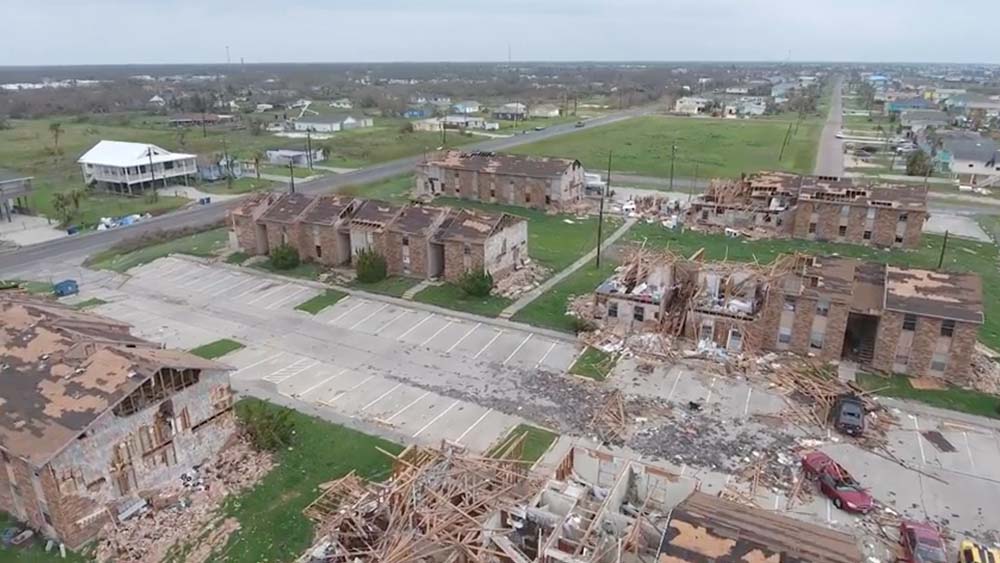
In the aftermath of a natural disaster, helping people get back on their feet as quickly as possible is a high priority. However, the road to recovery can be long. In the wake of natural disasters such as hurricanes Harvey and Maria, areas of Puerto Rico and Texas are both still in the midst of a long recovery process. However, what if there was a way to move recovery efforts along more quickly for residents in these communities and be better prepared for such events in the future?
Drs. Maria Koliou and Stephanie Paal, assistant professors in the Zachry Department of Civil Engineering at Texas A&M University, are conducting new research to learn how communities both recover from natural disasters and withstand them. Koliou and Paal are working on developing ways to automate the process of damage assessment that occurs after natural disasters, allowing damage assessors to move more quickly in determining what efforts need to be prioritized for optimal post-disaster functionality and recovery.
 “With this research, we’re interested in how the community recovers,” Koliou said. “We’re evaluating structural damage and community-level recovery that will allow us to develop a holistic framework for quantifying and enhancing community resilience following natural disasters.”
“With this research, we’re interested in how the community recovers,” Koliou said. “We’re evaluating structural damage and community-level recovery that will allow us to develop a holistic framework for quantifying and enhancing community resilience following natural disasters.”During the damage assessment process, an engineer will go to an area and evaluate the state of each individual structure, looking at what components may have been damaged. Then, based on the type of components and the extent of the damage, the engineer will give it a subjective rating: slightly damaged, moderately damaged or severely damaged, commonly associated with tagging (green, yellow or red). This rating plays a role in determining how much access a resident can have to the building, ascertaining what materials and time tables are needed for repairs, and what financial support will be drawn from different government entities.
 “The reason we want to automate this process is because right now it’s highly subjective,” Paal said. “In the first part of the process we’re evaluating the damage and looking at what should be prioritized for recovery, so it’s important that this is as objective and accurate a process as possible.”
“The reason we want to automate this process is because right now it’s highly subjective,” Paal said. “In the first part of the process we’re evaluating the damage and looking at what should be prioritized for recovery, so it’s important that this is as objective and accurate a process as possible.”The goal is to use machine learning, in combination with unmanned aerial systems such as drone technology, to identify key information a structural engineer would use to measure the extent of structural damage and provide a rating. According to Paal, using machine learning can provide assessment solutions that are more quantifiably meaningful to an engineer. This will provide engineers with better tools to measure the extent of the damage and piece data together, which in addition to past data and experiences, will help them develop the best path forward for recovery.
The first step in making an automated damage assessment process a reality is the development of the machine learning algorithm. Koliou, Paal and their students visited the coastal community of Port Aransas, Texas, in September 2017 and again in March 2018 to conduct damage assessments utilizing engineering surveys with video and drone technology. The collected data is being used to quantify the damage and recovery of the affected infrastructure as well as develop machine learning algorithms to automate damage inspections based on visual, real-world data. The end goal is to provide an interface that makes damage assessment quicker and more efficient, as well as develop a holistic framework for measuring the community’s level of recovery from a disaster.
“The whole idea is to make these processes quick and provide safe and reliable information in real time,” Paal said. “One of our project goals is to develop an interface through the drone that (informs) emergency response personnel what the current state of a structure is and tells you whether it is safe to go in or not.”
Looking forward, Koliou and Paal are planning on performing regular field studies every few months for the next three years to monitor recovery efforts, looking not only at the built infrastructure recovery, but at how the people in the community are recovering. Their goal will be to further identify indicators within the communities and see what factors can expedite or slow a community’s recovery process.
They are also looking at expanding their study to other coastal areas. Using Port Aransas as a case study, they plan to develop a methodology that can be extended to quantify recovery in other coastal communities and propose solutions for enhancing their recovery progress.
“Different systems within a community are connected,” Koliou said. “We’re trying to identify the different linkages between societal, economic and engineering aspects to identify how these attributes work together to affect the people of these communities and their lives, and how to get them back to a better quality of life following natural disasters.”
This research was possible in part thanks to the work of students at Texas A&M, including doctoral student Mohammad Aghababaei, undergraduate student Mary-Catherine Haggard and graduate research assistant Asim Bashir. The field research for this project was partially funded by the U.S. Department of Commerce’s National Oceanic and Atmospheric Administration through a Texas Sea Grant in which Koliou serves as the principal investigator. Koliou and Paal will continue their work in this area supported by a newly awarded grant from the National Association of Home Builders on the “Damage Assessment of Residential Infrastructure Impacted by Hurricane Harvey and Irma.”